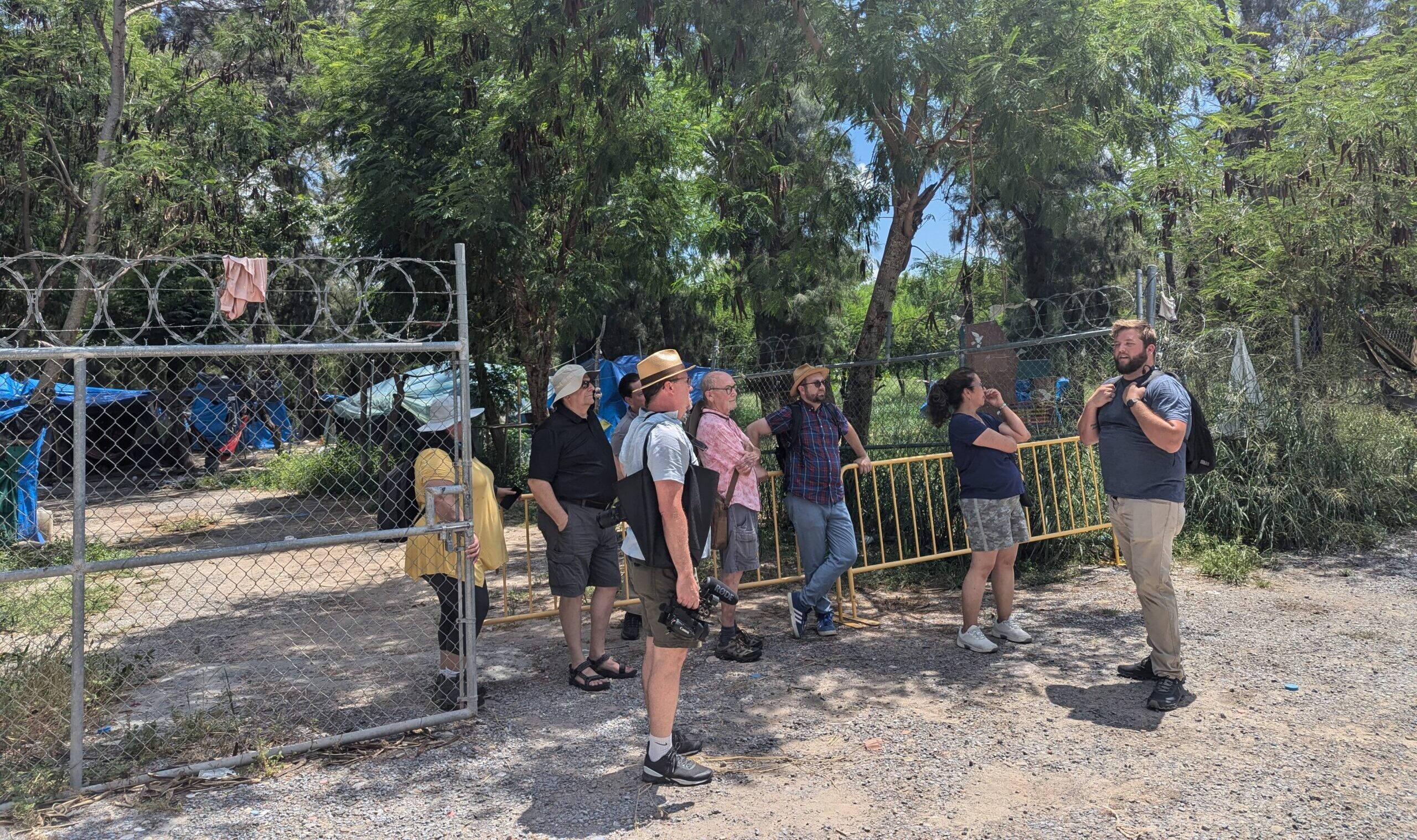Last week, I had the opportunity to tell you about the first hand look and briefings I received on my trip to the Mexico/US border. The purpose of the trip was to understand more about the immigration process and problems at the Mexico/United States border.
The trip was organized by First Unitarian Universalist. I joined Michelle, a staff member from Texas UU Justice Ministry, three members of First, their Senior Minister, Reverend Colin and their AV & Communications Coordinator, Christian. We were guided through Brownsville, McAllen and Harlingen by Fabiola from Texas Impact, which runs these 2-day immersion experiences designed to build understanding of the many challenges facing people in human mobility conditions and public servants at the Texas-Mexico border.
As I mentioned on Sunday, the trip was enlightening. I thought I had a pretty good understanding about what was going on at the border. Let me tell you, I was wrong. I had to pick and choose what made it into the Sunday service, but here, I can give a lot more detail.
This was my first trip to south Texas, my first trip to the border, but not my first trip to Mexico. The Mexico-United States border runs through an area that doesn’t look that much different than most of rural south Texas (from what I’ve seen so far). It’s large. It’s greenish in places, brownish in other places and flat in all places. Very flat. Outside of the cities, people, animals and trees are all pretty sparse. Most activity is centered around the farms. We saw a lot of rural poverty with a smattering of wealth. It’s big, it’s flat, it’s rugged and it’s hot.
Brownsville could be any south Texas town – not that I’m an expert. There is a college and a town square, parking lots and even a retail pedestrian zone. It seemed nice enough.
As much as the Brownsville side of the border felt like south Texas, across the border in Matamoros it definitely felt like Mexico. We stopped at a clinic and a shelter both providing services to people in human mobility conditions. We also toured a refugee camp that had once held 7,000 people and was now down to about 40.
The international border itself is in the middle of the Rio Grande River, which in the two places I saw was not “grande” at all – more swampi
sh. The US-built wall tracks alongside it. In Brownsville, the river and the wall are very close and there were no noticeable gaps in the wall. However, on our ninety minute drive from Brownsville to McAllen, we couldn’t help but notice that in some places the wall is a wall, but in most places, the wall is more of a series of disconnected wall fragments. I think from space “the wall” might look like a Morse Code series of dots and dashes.

Border Crossing into Matamoros.
The border crossing itself in downtown Brownsville is a heavily fenced, razor-wired four lane bridge with a lot of barricades in each direction. We walked into Mexico which reminded me of crossing into Canada: the Mexican border agents more or less politely waved and wished us each a good day. On the way back into the United States, had it not been for the agents changing shifts in the middle of our group, our whole group, each of us with US passports, would have been through in a matter of minutes. I don’t even recall being asked for my passport. Passport holders from nations other than the United States had a much longer wait and faced more scrutiny.
Of course, a good number of the citizens of other nations were stopping at the border without a visa to ask for asylum. Visas are permission to enter a country with certain limitations that are applied for and received prior to arriving at that country. Asylum is the process of asking to be protected from being forced to return to wherever they came from. There were quite a number of asylum-seeking families. The waiting rooms reminded me of the DMV or a bus station.
You might think “Why risk arriving at the border without a visa?” Well, immigrating to the United States is expensive. Immigrant visas cost $675 for the first family member and then $325 for each additional family member. To put that in relative terms, one of the nations with the most applicants for asylum is Venezuela, where the average annual income per person is right around $2,624. Citizens of other countries are not much better off, so many folks are left with no choice but to risk going through the asylum process.
Earlier this year, President Biden made it even harder to understand and harder to manage. This change applied only to asylum seekers attempting to enter through the Mexico-US border who petition for asylum. Of course, this did nothing to resolve the reasons behind the petitions for asylum: the conditions under which these asylum seekers live in their home nations hasn’t gotten any better, they were just told not to bother coming here anymore.
The asylum system is very complex. I will say that after hearing it a couple times, I think I have my arms more or less around it, but there is a lot to it. I can absolutely understand how people from other cultures who aren’t accustomed to the United States’s brand of thinking might misunderstand it.
Actually, the one thread that runs throughout the entire discussion about immigration is misunderstanding. I am a United States citizen, familiar with our brand of thinking and I found out that I had misunderstood it. Media and politicians certainly magnify, distort and leverage this misunderstanding. Truly illegal entries (or “gotaways”, as the border agents call them) are conflated with people petitioning for asylum and as a result, both are treated with similar disdain by the media.
If you really want to
get into some of the numbers and all the different categories, check out this Fact Check article on the topic.
Of course, if you overstay your visa or don’t follow the asylum process, you, along with the “gotaways” would be truly here illegally, at least by current legal definitions.
Supporters of anti-immigration policies tend to portray immigrants as mentally ill criminal rapist degenerates. First of all, this is simply not supported by any actual fact. According to court records, only 0.43% of new court cases sought deportation orders based on any alleged criminal activity of the immigrant, apart from possible illegal entry. So, if they were degenerates, for some reason all but a very small number of them would seem to have stopped that behavior once they arrived in the United States. Clever disguise, I suppose.
Supporters of anti-immigration policies seem to want us to think that all immigrants have uniform characteristics; mostly that they’re bad people. Based on what I saw, if immigrants have anything at all in common, it’s that they’re all families with little kids. Another clever disguise, I suppose.
On top of policy and rhetorical hostility and cruelty, the State of Texas has implemented its own anti-immigration measures, despite the absence of any legal authority to do so. We heard anecdotally of one man who was trying to cross the border between border stations (trying to become a “gotaway”) who had gotten tangled in some of Texas’ razor wire. It took the state three days to free him. Due to Texas’ efforts, those who are still trying to enter legally are preferring to do so through Arizona or California.
For me, the border was not scary, probably because I had nothing to be afraid of as a US passport holder. It was a sad, man-made disaster that is completely fixable. The only thing that I could see that we lacked was will power. We have all the will power in the world to stir people into a frenzy and then throw money into a Morse Code wall. I am left hoping that one day, we might be capable of directing that will power into fixing the problems that cause so many families to flee their homes rather than just manipulating their desperation for some pathetic political gain. I believe the world has a right to demand that of us.






